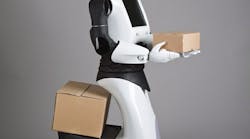Efficiency and better productivity remain chief goals at manufacturing organizations around the world—especially in a slow-growth economy and as new technologies continue to change the business landscape. Robotics is an area that continues to change with the times, as guest blogger Kyle Jacques points out in this quick list of what’s new on the robotics landscape.
- Clearpath Robotics
Clearpath’s website is probably their best advertising tool. The home page shows a clip of the self-driving Otto 1500 navigating through a factory space. It turns, stops to make a scheduled delivery, and pauses to allow another Otto 1500 to pass by.
The company offers solutions to automate tasks in industrial settings. The Otto 1500 is a self-driving vehicle built to navigate through a factory. Clearpath’s self-driving vehicles are also available for other industries, including mining, defense, and agriculture.
Clearpath Robotics is a Canadian-based robotics firm. In addition to the Otto 1500, it offers a number of other products: utility vehicles built to cross rugged terrain, unmanned drones, and a surface vehicle to navigate through water.
- Locus Robotics
Locus Robotics is offering a similar solution. Their robots are designed to navigate through your factory space and avoid obstacles. Compared to the Otto 1500, the robots are smaller and carry smaller products. The advantage is that they are able to work in environments with limited space.
- Vecna
Vecna offers solutions for several industries, including factory, medical, and hospitality.
Again, similar to the Otto 1500, their robots can be used to find and transport materials within factories. Easy touch screens allow users to input tasks.
Vecna’s robots are also used in medical settings. The robots are equipped with controls that limit or authorize user access, enabling certain personnel to access locked compartments within the robot (primarily for dispensing drugs). The robots can also record user actions so that any mishaps can be traced.
- Aura Robotics
Aura Robotics is developing driverless shuttle vehicles. The company has already started doing test runs at Santa Clara University in the Bay Area and plan on making the first vehicles available by 2016. The shuttles can be used for a number of different environments including campuses, retirement homes, theme parks and resorts.
Passengers can input the destination via a mobile app or an on-vehicle touchscreen. The mapping software will then calculate the optimum route to the destination.
- Cyberdyne
Cyberdyne provides a support device for lower limb movement. The suit enables a connection between the wearer’s brain and lower limbs so that movement is possible. The support systems works by picking up the user’s thoughts. Whenever the user thinks “I want to stand up” or “I want to walk,” the suit picks up the signals, allowing the user to become mobile.
- PAL Robotics
behind Reem and Reem-C, the full-size humanoid service robot. Reem-C is the advanced version of Reem, and the robot is capable of walking. The robots can be used in a number of settings. They are built to navigate through crowded areas, provide guidance, and speak in nine languages.
Kyle Jacques is president of Luxe Electronics, an electronic component distributor based in Amesbury, Massachusetts.









